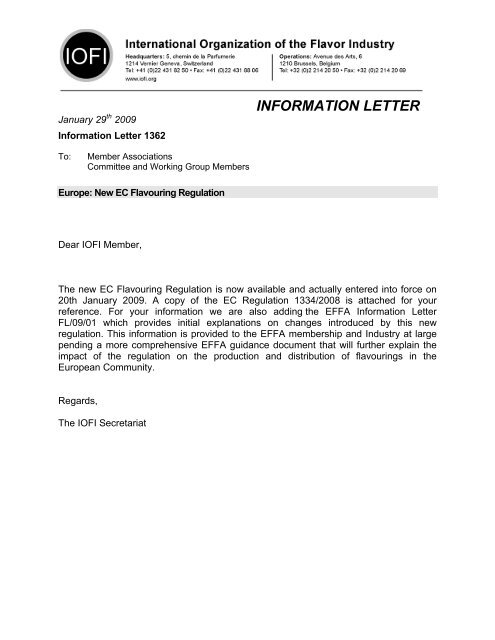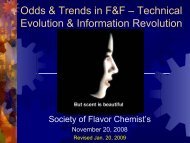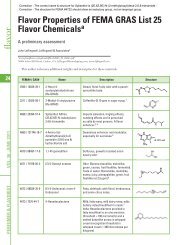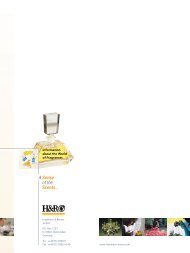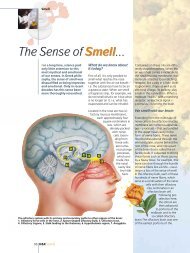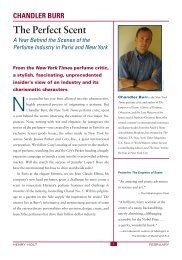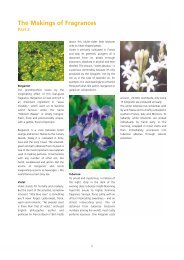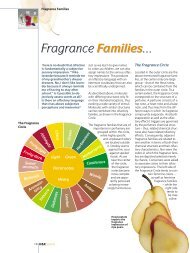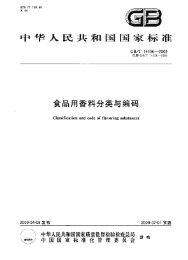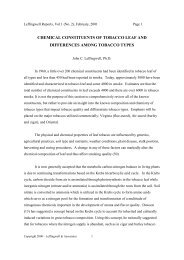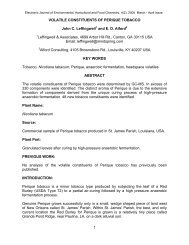INFORMATION LETTER - Leffingwell & Associates
INFORMATION LETTER - Leffingwell & Associates
INFORMATION LETTER - Leffingwell & Associates
Create successful ePaper yourself
Turn your PDF publications into a flip-book with our unique Google optimized e-Paper software.
January 29 th 2009<br />
Information Letter 1362<br />
<strong>INFORMATION</strong> <strong>LETTER</strong><br />
To:<br />
Member Associations<br />
Committee and Working Group Members<br />
Europe: New EC Flavouring Regulation<br />
Dear IOFI Member,<br />
The new EC Flavouring Regulation is now available and actually entered into force on<br />
20th January 2009. A copy of the EC Regulation 1334/2008 is attached for your<br />
reference. For your information we are also adding the EFFA Information Letter<br />
FL/09/01 which provides initial explanations on changes introduced by this new<br />
regulation. This information is provided to the EFFA membership and Industry at large<br />
pending a more comprehensive EFFA guidance document that will further explain the<br />
impact of the regulation on the production and distribution of flavourings in the<br />
European Community.<br />
Regards,<br />
The IOFI Secretariat
EFFA Information Letter FL/09/01 Page 1/3<br />
EC Regulation on Flavourings<br />
On July 8 th the European Parliament (EP) voted for the FIAP (Food Improvement Agents<br />
Package) compromises including a Regulation on Flavourings. The final regulation of the<br />
EP and Council on Flavourings was published on December, 31, 2008. 1 The Regulation will<br />
be binding as of January 20, 2011 which is 24 months after its entry into force. During these<br />
24 months transitional period, current national legislation will still be in force.<br />
EFFA welcomes review and updating of the flavourings legislation.<br />
This document summarizes the major changes introduced in the new Regulation; it does not<br />
comment on the changes requiring interpretation, which will be included in an EFFA<br />
Guidance Document currently under elaboration.<br />
Key issues are:<br />
Scope<br />
<br />
The title and scope cover flavourings for use in and on foods, certain food ingredients<br />
with flavouring properties, food containing flavourings and/or food ingredients with<br />
flavouring properties and source materials.<br />
Definitions<br />
The general definition of flavourings is to impart or modify odour and/or taste of the<br />
foods to which they are added.<br />
No distinction is made between nature-identical and artificial flavouring substances,<br />
both of which will be regarded as “Flavouring substances”.<br />
Two additional flavouring categories are defined i.e. “flavour precursors” and “other<br />
flavourings”.<br />
Process flavourings are named “Thermal process flavourings”: production conditions<br />
and maximum levels for certain substances are set.<br />
Requirements concerning the processes allowed for natural flavouring substances<br />
and flavouring preparations are specified.<br />
A distinction is established between source materials considered as “food” and “nonfood”.<br />
1<br />
REGULATION (EC) No 1334/2008 OF THE EUROPEAN PARLIAMENT AND OF THE COUNCIL<br />
of 16 December 2008 on flavourings and certain food ingredients with flavouring properties for use<br />
in and on foods and amending Council Regulation (EEC) No 1601/91, Regulations (EC)<br />
No 2232/96 and (EC) No 110/2008 and Directive 2000/13/EC – OJ L 354, 31.12.2008, p. 34.<br />
Avenue des Arts, 6 – B - 1210 Bruxelles<br />
Tel: +32 2 214 20 40 - Fax: +32 2 230 02 65 - E-mail: secretariat@effaorg.org<br />
Bank account number: 001-5022485-95<br />
VAT BE 538.183.219
EFFA Information Letter FL/09/01 Page 2/3<br />
Labelling<br />
Packaging labelling of flavourings for downstream manufacturers and consumers<br />
must include details about the presence of food allergens and date of minimum<br />
durability.<br />
Labelling as “natural flavouring substance(s)” may only be used for flavourings where<br />
the flavouring part contains exclusively natural flavouring substances.<br />
Labelling as “natural X flavouring” with reference to the name of the source may only<br />
be used if the flavouring component has been obtained exclusively or by at least 95%<br />
(w/w) from the cited source, the other maximum 5% (w/w) must also be natural.<br />
<br />
Labelling as “natural X flavouring with other natural flavourings” may only be used<br />
when the flavouring component has been partially derived from the cited source and<br />
the flavour of the source is easily recognizable.<br />
Labelling as “natural flavouring” without reference to the name of the source may<br />
only be used when a flavour is derived from different source materials and a<br />
reference to the source materials would not reflect their flavour or taste.<br />
<br />
Smoke flavourings added to impart smoky flavour to the food must appear in the list<br />
of ingredients, either as “smoke flavouring(s)” or with a reference to the source<br />
(wood) used for its production.<br />
Evaluation and authorisation<br />
<br />
A Community List will be established for:<br />
- flavouring substances;<br />
- other flavourings;<br />
- flavourings from the following flavouring categories when obtained from non-food<br />
sources: thermal process flavourings, flavour precursors, flavouring preparations;<br />
- source materials other than food;<br />
- thermal process flavourings for which the production conditions and/or the<br />
maximum levels for certain undesirable substances as set out in Annex V are not<br />
met.<br />
Risk management of certain substances<br />
<br />
The risk management of certain substances naturally present in certain food<br />
ingredients with flavouring properties (e.g. herbs, spices) and/or flavourings is<br />
based upon the “major contributor approach”:<br />
- Maximum levels 2 are established for the presence of these undesirable<br />
substances in food which contribute most to the human intake of these<br />
substances.<br />
- Only food ingredients with flavouring properties contributing most to the intake<br />
are considered.<br />
2<br />
The maximum levels shall not apply to estragole, methyleugenol and safrole where a compound<br />
food contains no added flavourings and the only food ingredients with flavouring properties that<br />
have been added are fresh, dried or frozen herbs and spices.
EFFA Information Letter FL/09/01 Page 3/3<br />
A general list of substances that should not be added as such to foods is provided in<br />
Annex III A.<br />
Flavouring and foodstuff manufacturers must, at the request of the Commission,<br />
provide information on the consumption and use of flavourings in specific<br />
categories of foods.<br />
Regulatory aspects<br />
The text is a Regulation and no longer a Directive; this allows a more rapid and<br />
harmonized enforcement.<br />
The introduction of the Comitology procedure – “regulatory procedure with scrutiny” –<br />
will lead to a more rapid adaptation of the provisions to technical progress.<br />
All former standards (national legislation, EU or national codes of practice, other<br />
vertical legislation etc.) based upon a differentiation between nature-identical and<br />
artificial substances will require amending between the entry into force of the text<br />
(January 20, 2009) and its application, 24 months later (January 20, 2011).<br />
<br />
Apart from some exceptions the new EC flavouring Regulation will be binding as of<br />
January 20, 2011 which is 24 months after it has come into force. During this period<br />
of time Member States must adapt their national legislation.<br />
The Community List of flavouring substances which will become Annex I of this<br />
regulation will have a different publication and application date (see separate EFFA<br />
IL 08/01 on the Community List of flavouring substances).<br />
January 6, 2009
EFFA Information Letter FL/09/01 Page 3/3<br />
A general list of substances that should not be added as such to foods is provided in<br />
Annex III A.<br />
Flavouring and foodstuff manufacturers must, at the request of the Commission,<br />
provide information on the consumption and use of flavourings in specific<br />
categories of foods.<br />
Regulatory aspects<br />
The text is a Regulation and no longer a Directive; this allows a more rapid and<br />
harmonized enforcement.<br />
The introduction of the Comitology procedure – “regulatory procedure with scrutiny” –<br />
will lead to a more rapid adaptation of the provisions to technical progress.<br />
All former standards (national legislation, EU or national codes of practice, other<br />
vertical legislation etc.) based upon a differentiation between nature-identical and<br />
artificial substances will require amending between the entry into force of the text<br />
(January 20, 2009) and its application, 24 months later (January 20, 2011).<br />
<br />
Apart from some exceptions the new EC flavouring Regulation will be binding as of<br />
January 20, 2011 which is 24 months after it has come into force. During this period<br />
of time Member States must adapt their national legislation.<br />
The Community List of flavouring substances which will become Annex I of this<br />
regulation will have a different publication and application date (see separate EFFA<br />
IL 08/01 on the Community List of flavouring substances).<br />
January 6, 2009
EFFA Information Letter FL/09/01 Page 3/3<br />
A general list of substances that should not be added as such to foods is provided in<br />
Annex III A.<br />
Flavouring and foodstuff manufacturers must, at the request of the Commission,<br />
provide information on the consumption and use of flavourings in specific<br />
categories of foods.<br />
Regulatory aspects<br />
The text is a Regulation and no longer a Directive; this allows a more rapid and<br />
harmonized enforcement.<br />
The introduction of the Comitology procedure – “regulatory procedure with scrutiny” –<br />
will lead to a more rapid adaptation of the provisions to technical progress.<br />
All former standards (national legislation, EU or national codes of practice, other<br />
vertical legislation etc.) based upon a differentiation between nature-identical and<br />
artificial substances will require amending between the entry into force of the text<br />
(January 20, 2009) and its application, 24 months later (January 20, 2011).<br />
<br />
Apart from some exceptions the new EC flavouring Regulation will be binding as of<br />
January 20, 2011 which is 24 months after it has come into force. During this period<br />
of time Member States must adapt their national legislation.<br />
The Community List of flavouring substances which will become Annex I of this<br />
regulation will have a different publication and application date (see separate EFFA<br />
IL 08/01 on the Community List of flavouring substances).<br />
January 6, 2009
EFFA Information Letter FL/09/01 Page 3/3<br />
A general list of substances that should not be added as such to foods is provided in<br />
Annex III A.<br />
Flavouring and foodstuff manufacturers must, at the request of the Commission,<br />
provide information on the consumption and use of flavourings in specific<br />
categories of foods.<br />
Regulatory aspects<br />
The text is a Regulation and no longer a Directive; this allows a more rapid and<br />
harmonized enforcement.<br />
The introduction of the Comitology procedure – “regulatory procedure with scrutiny” –<br />
will lead to a more rapid adaptation of the provisions to technical progress.<br />
All former standards (national legislation, EU or national codes of practice, other<br />
vertical legislation etc.) based upon a differentiation between nature-identical and<br />
artificial substances will require amending between the entry into force of the text<br />
(January 20, 2009) and its application, 24 months later (January 20, 2011).<br />
<br />
Apart from some exceptions the new EC flavouring Regulation will be binding as of<br />
January 20, 2011 which is 24 months after it has come into force. During this period<br />
of time Member States must adapt their national legislation.<br />
The Community List of flavouring substances which will become Annex I of this<br />
regulation will have a different publication and application date (see separate EFFA<br />
IL 08/01 on the Community List of flavouring substances).<br />
January 6, 2009
EFFA Information Letter FL/09/01 Page 3/3<br />
A general list of substances that should not be added as such to foods is provided in<br />
Annex III A.<br />
Flavouring and foodstuff manufacturers must, at the request of the Commission,<br />
provide information on the consumption and use of flavourings in specific<br />
categories of foods.<br />
Regulatory aspects<br />
The text is a Regulation and no longer a Directive; this allows a more rapid and<br />
harmonized enforcement.<br />
The introduction of the Comitology procedure – “regulatory procedure with scrutiny” –<br />
will lead to a more rapid adaptation of the provisions to technical progress.<br />
All former standards (national legislation, EU or national codes of practice, other<br />
vertical legislation etc.) based upon a differentiation between nature-identical and<br />
artificial substances will require amending between the entry into force of the text<br />
(January 20, 2009) and its application, 24 months later (January 20, 2011).<br />
<br />
Apart from some exceptions the new EC flavouring Regulation will be binding as of<br />
January 20, 2011 which is 24 months after it has come into force. During this period<br />
of time Member States must adapt their national legislation.<br />
The Community List of flavouring substances which will become Annex I of this<br />
regulation will have a different publication and application date (see separate EFFA<br />
IL 08/01 on the Community List of flavouring substances).<br />
January 6, 2009
EFFA Information Letter FL/09/01 Page 3/3<br />
A general list of substances that should not be added as such to foods is provided in<br />
Annex III A.<br />
Flavouring and foodstuff manufacturers must, at the request of the Commission,<br />
provide information on the consumption and use of flavourings in specific<br />
categories of foods.<br />
Regulatory aspects<br />
The text is a Regulation and no longer a Directive; this allows a more rapid and<br />
harmonized enforcement.<br />
The introduction of the Comitology procedure – “regulatory procedure with scrutiny” –<br />
will lead to a more rapid adaptation of the provisions to technical progress.<br />
All former standards (national legislation, EU or national codes of practice, other<br />
vertical legislation etc.) based upon a differentiation between nature-identical and<br />
artificial substances will require amending between the entry into force of the text<br />
(January 20, 2009) and its application, 24 months later (January 20, 2011).<br />
<br />
Apart from some exceptions the new EC flavouring Regulation will be binding as of<br />
January 20, 2011 which is 24 months after it has come into force. During this period<br />
of time Member States must adapt their national legislation.<br />
The Community List of flavouring substances which will become Annex I of this<br />
regulation will have a different publication and application date (see separate EFFA<br />
IL 08/01 on the Community List of flavouring substances).<br />
January 6, 2009
EFFA Information Letter FL/09/01 Page 3/3<br />
A general list of substances that should not be added as such to foods is provided in<br />
Annex III A.<br />
Flavouring and foodstuff manufacturers must, at the request of the Commission,<br />
provide information on the consumption and use of flavourings in specific<br />
categories of foods.<br />
Regulatory aspects<br />
The text is a Regulation and no longer a Directive; this allows a more rapid and<br />
harmonized enforcement.<br />
The introduction of the Comitology procedure – “regulatory procedure with scrutiny” –<br />
will lead to a more rapid adaptation of the provisions to technical progress.<br />
All former standards (national legislation, EU or national codes of practice, other<br />
vertical legislation etc.) based upon a differentiation between nature-identical and<br />
artificial substances will require amending between the entry into force of the text<br />
(January 20, 2009) and its application, 24 months later (January 20, 2011).<br />
<br />
Apart from some exceptions the new EC flavouring Regulation will be binding as of<br />
January 20, 2011 which is 24 months after it has come into force. During this period<br />
of time Member States must adapt their national legislation.<br />
The Community List of flavouring substances which will become Annex I of this<br />
regulation will have a different publication and application date (see separate EFFA<br />
IL 08/01 on the Community List of flavouring substances).<br />
January 6, 2009
EFFA Information Letter FL/09/01 Page 3/3<br />
A general list of substances that should not be added as such to foods is provided in<br />
Annex III A.<br />
Flavouring and foodstuff manufacturers must, at the request of the Commission,<br />
provide information on the consumption and use of flavourings in specific<br />
categories of foods.<br />
Regulatory aspects<br />
The text is a Regulation and no longer a Directive; this allows a more rapid and<br />
harmonized enforcement.<br />
The introduction of the Comitology procedure – “regulatory procedure with scrutiny” –<br />
will lead to a more rapid adaptation of the provisions to technical progress.<br />
All former standards (national legislation, EU or national codes of practice, other<br />
vertical legislation etc.) based upon a differentiation between nature-identical and<br />
artificial substances will require amending between the entry into force of the text<br />
(January 20, 2009) and its application, 24 months later (January 20, 2011).<br />
<br />
Apart from some exceptions the new EC flavouring Regulation will be binding as of<br />
January 20, 2011 which is 24 months after it has come into force. During this period<br />
of time Member States must adapt their national legislation.<br />
The Community List of flavouring substances which will become Annex I of this<br />
regulation will have a different publication and application date (see separate EFFA<br />
IL 08/01 on the Community List of flavouring substances).<br />
January 6, 2009
EFFA Information Letter FL/09/01 Page 3/3<br />
A general list of substances that should not be added as such to foods is provided in<br />
Annex III A.<br />
Flavouring and foodstuff manufacturers must, at the request of the Commission,<br />
provide information on the consumption and use of flavourings in specific<br />
categories of foods.<br />
Regulatory aspects<br />
The text is a Regulation and no longer a Directive; this allows a more rapid and<br />
harmonized enforcement.<br />
The introduction of the Comitology procedure – “regulatory procedure with scrutiny” –<br />
will lead to a more rapid adaptation of the provisions to technical progress.<br />
All former standards (national legislation, EU or national codes of practice, other<br />
vertical legislation etc.) based upon a differentiation between nature-identical and<br />
artificial substances will require amending between the entry into force of the text<br />
(January 20, 2009) and its application, 24 months later (January 20, 2011).<br />
<br />
Apart from some exceptions the new EC flavouring Regulation will be binding as of<br />
January 20, 2011 which is 24 months after it has come into force. During this period<br />
of time Member States must adapt their national legislation.<br />
The Community List of flavouring substances which will become Annex I of this<br />
regulation will have a different publication and application date (see separate EFFA<br />
IL 08/01 on the Community List of flavouring substances).<br />
January 6, 2009
EFFA Information Letter FL/09/01 Page 3/3<br />
A general list of substances that should not be added as such to foods is provided in<br />
Annex III A.<br />
Flavouring and foodstuff manufacturers must, at the request of the Commission,<br />
provide information on the consumption and use of flavourings in specific<br />
categories of foods.<br />
Regulatory aspects<br />
The text is a Regulation and no longer a Directive; this allows a more rapid and<br />
harmonized enforcement.<br />
The introduction of the Comitology procedure – “regulatory procedure with scrutiny” –<br />
will lead to a more rapid adaptation of the provisions to technical progress.<br />
All former standards (national legislation, EU or national codes of practice, other<br />
vertical legislation etc.) based upon a differentiation between nature-identical and<br />
artificial substances will require amending between the entry into force of the text<br />
(January 20, 2009) and its application, 24 months later (January 20, 2011).<br />
<br />
Apart from some exceptions the new EC flavouring Regulation will be binding as of<br />
January 20, 2011 which is 24 months after it has come into force. During this period<br />
of time Member States must adapt their national legislation.<br />
The Community List of flavouring substances which will become Annex I of this<br />
regulation will have a different publication and application date (see separate EFFA<br />
IL 08/01 on the Community List of flavouring substances).<br />
January 6, 2009
EFFA Information Letter FL/09/01 Page 3/3<br />
A general list of substances that should not be added as such to foods is provided in<br />
Annex III A.<br />
Flavouring and foodstuff manufacturers must, at the request of the Commission,<br />
provide information on the consumption and use of flavourings in specific<br />
categories of foods.<br />
Regulatory aspects<br />
The text is a Regulation and no longer a Directive; this allows a more rapid and<br />
harmonized enforcement.<br />
The introduction of the Comitology procedure – “regulatory procedure with scrutiny” –<br />
will lead to a more rapid adaptation of the provisions to technical progress.<br />
All former standards (national legislation, EU or national codes of practice, other<br />
vertical legislation etc.) based upon a differentiation between nature-identical and<br />
artificial substances will require amending between the entry into force of the text<br />
(January 20, 2009) and its application, 24 months later (January 20, 2011).<br />
<br />
Apart from some exceptions the new EC flavouring Regulation will be binding as of<br />
January 20, 2011 which is 24 months after it has come into force. During this period<br />
of time Member States must adapt their national legislation.<br />
The Community List of flavouring substances which will become Annex I of this<br />
regulation will have a different publication and application date (see separate EFFA<br />
IL 08/01 on the Community List of flavouring substances).<br />
January 6, 2009
EFFA Information Letter FL/09/01 Page 3/3<br />
A general list of substances that should not be added as such to foods is provided in<br />
Annex III A.<br />
Flavouring and foodstuff manufacturers must, at the request of the Commission,<br />
provide information on the consumption and use of flavourings in specific<br />
categories of foods.<br />
Regulatory aspects<br />
The text is a Regulation and no longer a Directive; this allows a more rapid and<br />
harmonized enforcement.<br />
The introduction of the Comitology procedure – “regulatory procedure with scrutiny” –<br />
will lead to a more rapid adaptation of the provisions to technical progress.<br />
All former standards (national legislation, EU or national codes of practice, other<br />
vertical legislation etc.) based upon a differentiation between nature-identical and<br />
artificial substances will require amending between the entry into force of the text<br />
(January 20, 2009) and its application, 24 months later (January 20, 2011).<br />
<br />
Apart from some exceptions the new EC flavouring Regulation will be binding as of<br />
January 20, 2011 which is 24 months after it has come into force. During this period<br />
of time Member States must adapt their national legislation.<br />
The Community List of flavouring substances which will become Annex I of this<br />
regulation will have a different publication and application date (see separate EFFA<br />
IL 08/01 on the Community List of flavouring substances).<br />
January 6, 2009
EFFA Information Letter FL/09/01 Page 3/3<br />
A general list of substances that should not be added as such to foods is provided in<br />
Annex III A.<br />
Flavouring and foodstuff manufacturers must, at the request of the Commission,<br />
provide information on the consumption and use of flavourings in specific<br />
categories of foods.<br />
Regulatory aspects<br />
The text is a Regulation and no longer a Directive; this allows a more rapid and<br />
harmonized enforcement.<br />
The introduction of the Comitology procedure – “regulatory procedure with scrutiny” –<br />
will lead to a more rapid adaptation of the provisions to technical progress.<br />
All former standards (national legislation, EU or national codes of practice, other<br />
vertical legislation etc.) based upon a differentiation between nature-identical and<br />
artificial substances will require amending between the entry into force of the text<br />
(January 20, 2009) and its application, 24 months later (January 20, 2011).<br />
<br />
Apart from some exceptions the new EC flavouring Regulation will be binding as of<br />
January 20, 2011 which is 24 months after it has come into force. During this period<br />
of time Member States must adapt their national legislation.<br />
The Community List of flavouring substances which will become Annex I of this<br />
regulation will have a different publication and application date (see separate EFFA<br />
IL 08/01 on the Community List of flavouring substances).<br />
January 6, 2009
EFFA Information Letter FL/09/01 Page 3/3<br />
A general list of substances that should not be added as such to foods is provided in<br />
Annex III A.<br />
Flavouring and foodstuff manufacturers must, at the request of the Commission,<br />
provide information on the consumption and use of flavourings in specific<br />
categories of foods.<br />
Regulatory aspects<br />
The text is a Regulation and no longer a Directive; this allows a more rapid and<br />
harmonized enforcement.<br />
The introduction of the Comitology procedure – “regulatory procedure with scrutiny” –<br />
will lead to a more rapid adaptation of the provisions to technical progress.<br />
All former standards (national legislation, EU or national codes of practice, other<br />
vertical legislation etc.) based upon a differentiation between nature-identical and<br />
artificial substances will require amending between the entry into force of the text<br />
(January 20, 2009) and its application, 24 months later (January 20, 2011).<br />
<br />
Apart from some exceptions the new EC flavouring Regulation will be binding as of<br />
January 20, 2011 which is 24 months after it has come into force. During this period<br />
of time Member States must adapt their national legislation.<br />
The Community List of flavouring substances which will become Annex I of this<br />
regulation will have a different publication and application date (see separate EFFA<br />
IL 08/01 on the Community List of flavouring substances).<br />
January 6, 2009
EFFA Information Letter FL/09/01 Page 3/3<br />
A general list of substances that should not be added as such to foods is provided in<br />
Annex III A.<br />
Flavouring and foodstuff manufacturers must, at the request of the Commission,<br />
provide information on the consumption and use of flavourings in specific<br />
categories of foods.<br />
Regulatory aspects<br />
The text is a Regulation and no longer a Directive; this allows a more rapid and<br />
harmonized enforcement.<br />
The introduction of the Comitology procedure – “regulatory procedure with scrutiny” –<br />
will lead to a more rapid adaptation of the provisions to technical progress.<br />
All former standards (national legislation, EU or national codes of practice, other<br />
vertical legislation etc.) based upon a differentiation between nature-identical and<br />
artificial substances will require amending between the entry into force of the text<br />
(January 20, 2009) and its application, 24 months later (January 20, 2011).<br />
<br />
Apart from some exceptions the new EC flavouring Regulation will be binding as of<br />
January 20, 2011 which is 24 months after it has come into force. During this period<br />
of time Member States must adapt their national legislation.<br />
The Community List of flavouring substances which will become Annex I of this<br />
regulation will have a different publication and application date (see separate EFFA<br />
IL 08/01 on the Community List of flavouring substances).<br />
January 6, 2009
EFFA Information Letter FL/09/01 Page 3/3<br />
A general list of substances that should not be added as such to foods is provided in<br />
Annex III A.<br />
Flavouring and foodstuff manufacturers must, at the request of the Commission,<br />
provide information on the consumption and use of flavourings in specific<br />
categories of foods.<br />
Regulatory aspects<br />
The text is a Regulation and no longer a Directive; this allows a more rapid and<br />
harmonized enforcement.<br />
The introduction of the Comitology procedure – “regulatory procedure with scrutiny” –<br />
will lead to a more rapid adaptation of the provisions to technical progress.<br />
All former standards (national legislation, EU or national codes of practice, other<br />
vertical legislation etc.) based upon a differentiation between nature-identical and<br />
artificial substances will require amending between the entry into force of the text<br />
(January 20, 2009) and its application, 24 months later (January 20, 2011).<br />
<br />
Apart from some exceptions the new EC flavouring Regulation will be binding as of<br />
January 20, 2011 which is 24 months after it has come into force. During this period<br />
of time Member States must adapt their national legislation.<br />
The Community List of flavouring substances which will become Annex I of this<br />
regulation will have a different publication and application date (see separate EFFA<br />
IL 08/01 on the Community List of flavouring substances).<br />
January 6, 2009
EFFA Information Letter FL/09/01 Page 3/3<br />
A general list of substances that should not be added as such to foods is provided in<br />
Annex III A.<br />
Flavouring and foodstuff manufacturers must, at the request of the Commission,<br />
provide information on the consumption and use of flavourings in specific<br />
categories of foods.<br />
Regulatory aspects<br />
The text is a Regulation and no longer a Directive; this allows a more rapid and<br />
harmonized enforcement.<br />
The introduction of the Comitology procedure – “regulatory procedure with scrutiny” –<br />
will lead to a more rapid adaptation of the provisions to technical progress.<br />
All former standards (national legislation, EU or national codes of practice, other<br />
vertical legislation etc.) based upon a differentiation between nature-identical and<br />
artificial substances will require amending between the entry into force of the text<br />
(January 20, 2009) and its application, 24 months later (January 20, 2011).<br />
<br />
Apart from some exceptions the new EC flavouring Regulation will be binding as of<br />
January 20, 2011 which is 24 months after it has come into force. During this period<br />
of time Member States must adapt their national legislation.<br />
The Community List of flavouring substances which will become Annex I of this<br />
regulation will have a different publication and application date (see separate EFFA<br />
IL 08/01 on the Community List of flavouring substances).<br />
January 6, 2009
EFFA Information Letter FL/09/01 Page 3/3<br />
A general list of substances that should not be added as such to foods is provided in<br />
Annex III A.<br />
Flavouring and foodstuff manufacturers must, at the request of the Commission,<br />
provide information on the consumption and use of flavourings in specific<br />
categories of foods.<br />
Regulatory aspects<br />
The text is a Regulation and no longer a Directive; this allows a more rapid and<br />
harmonized enforcement.<br />
The introduction of the Comitology procedure – “regulatory procedure with scrutiny” –<br />
will lead to a more rapid adaptation of the provisions to technical progress.<br />
All former standards (national legislation, EU or national codes of practice, other<br />
vertical legislation etc.) based upon a differentiation between nature-identical and<br />
artificial substances will require amending between the entry into force of the text<br />
(January 20, 2009) and its application, 24 months later (January 20, 2011).<br />
<br />
Apart from some exceptions the new EC flavouring Regulation will be binding as of<br />
January 20, 2011 which is 24 months after it has come into force. During this period<br />
of time Member States must adapt their national legislation.<br />
The Community List of flavouring substances which will become Annex I of this<br />
regulation will have a different publication and application date (see separate EFFA<br />
IL 08/01 on the Community List of flavouring substances).<br />
January 6, 2009


